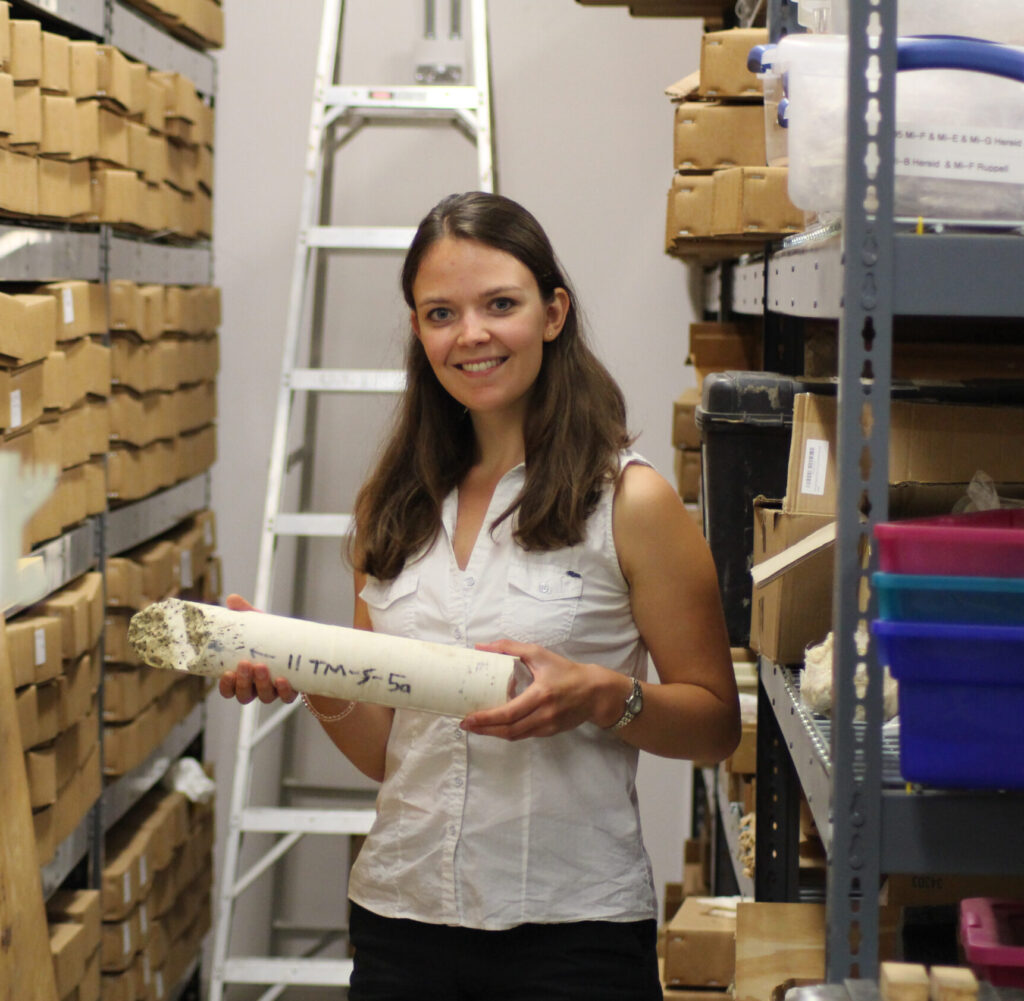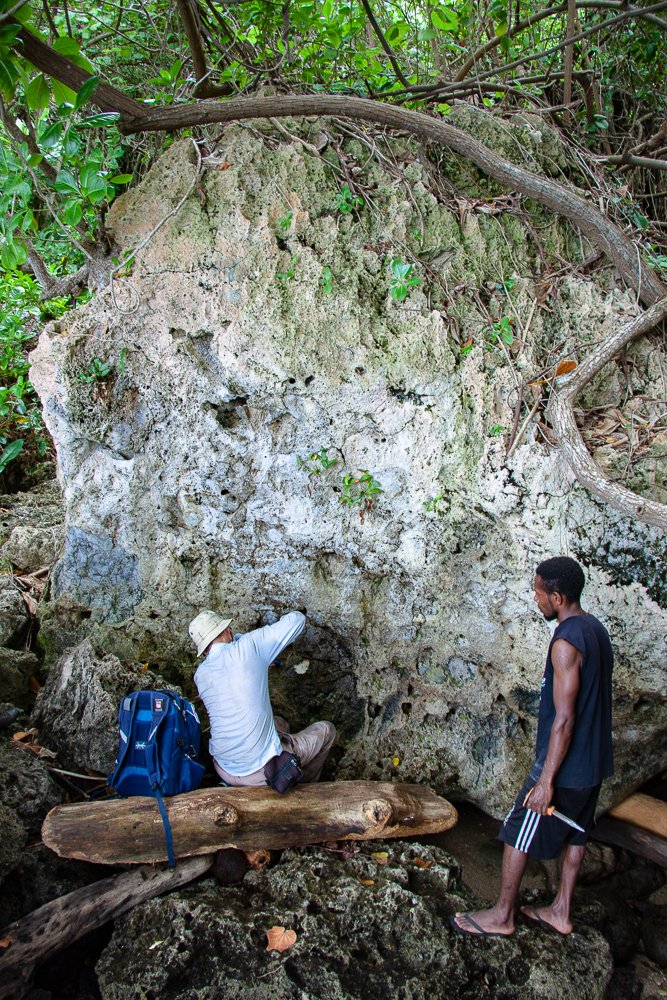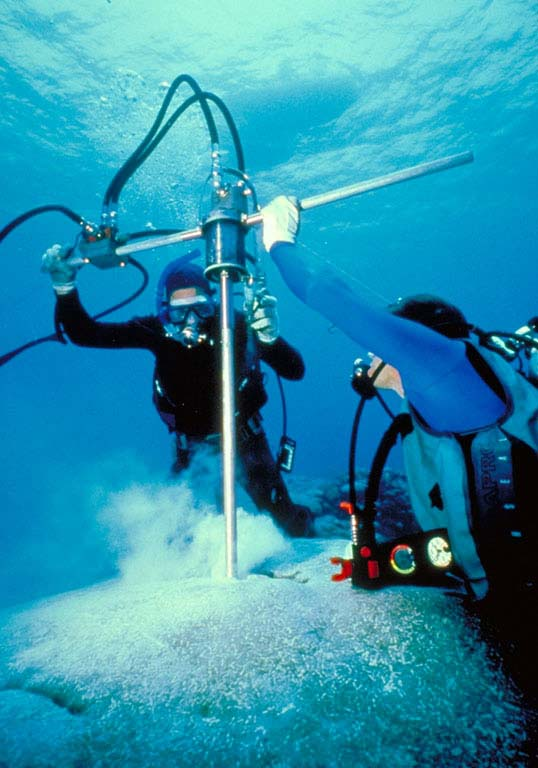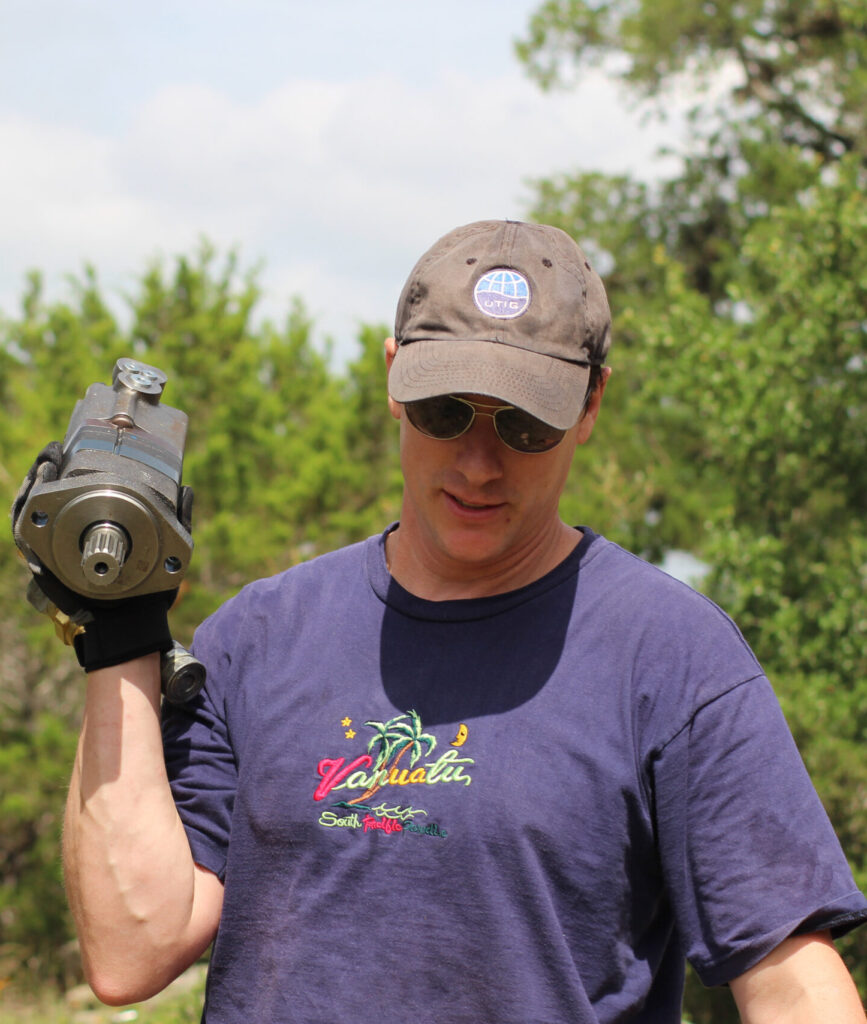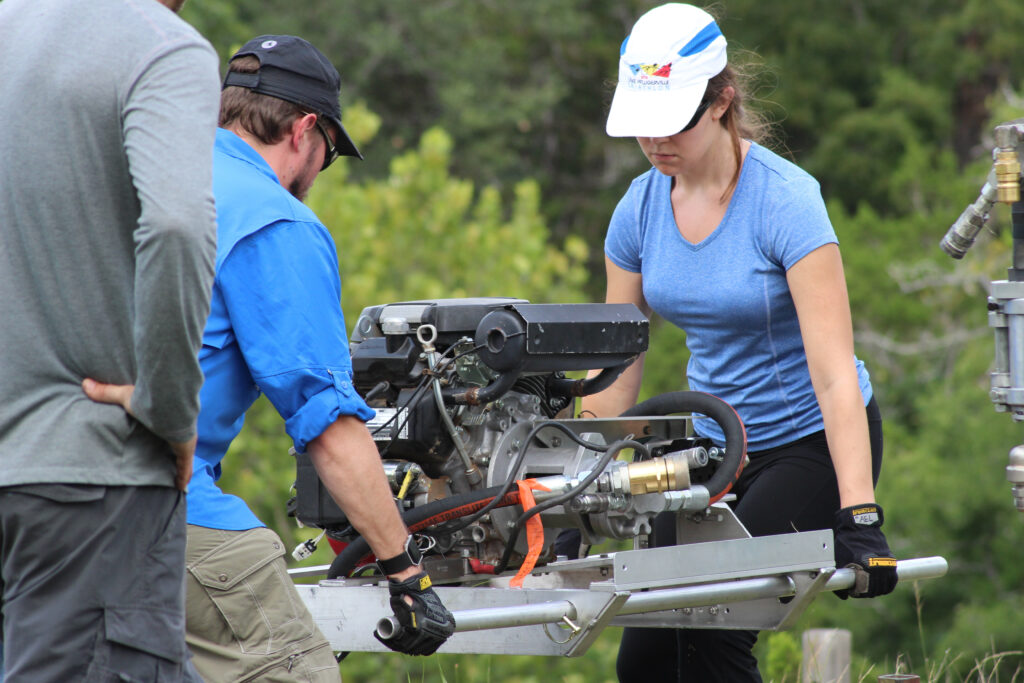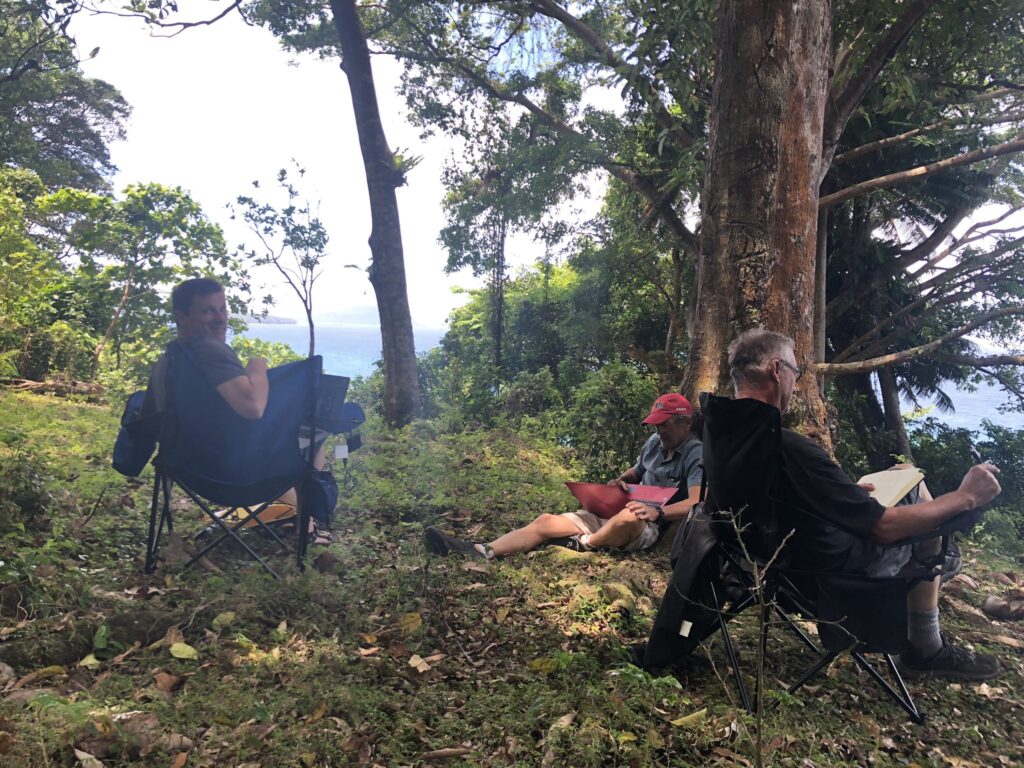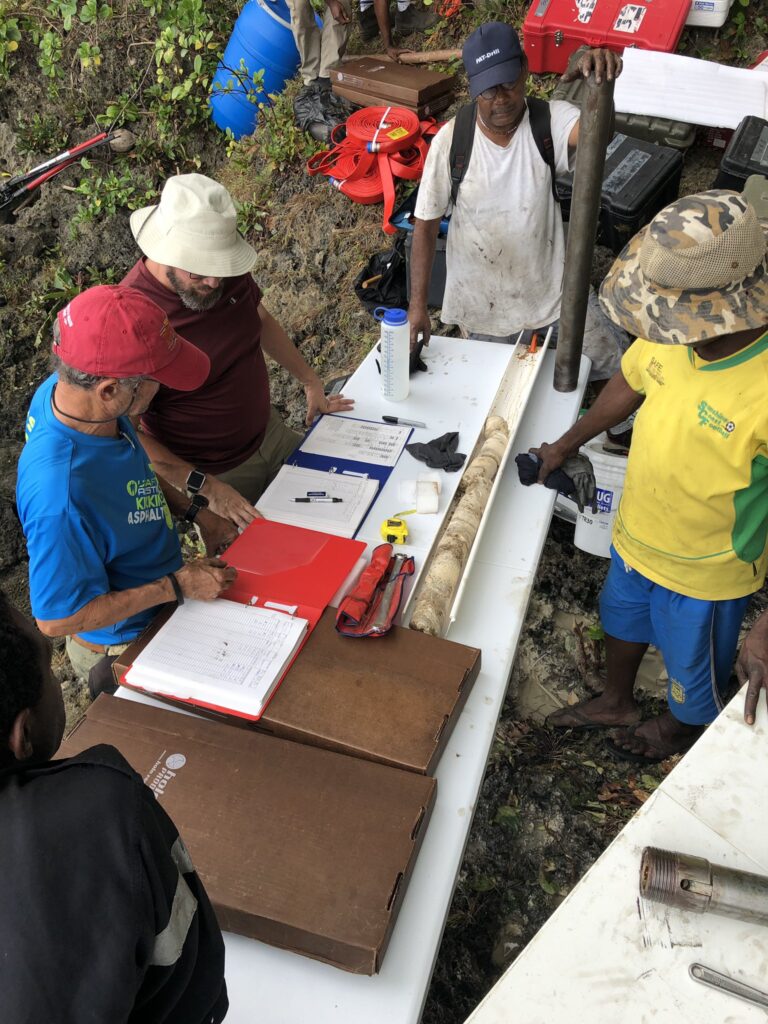These seasonal climate patterns are responsible for far-reaching and damaging weather events that affect the entire world. The University of Texas Institute for Geophysics is leading the way to understand how global climate change could be affecting them.
By Constantino Panagopulos
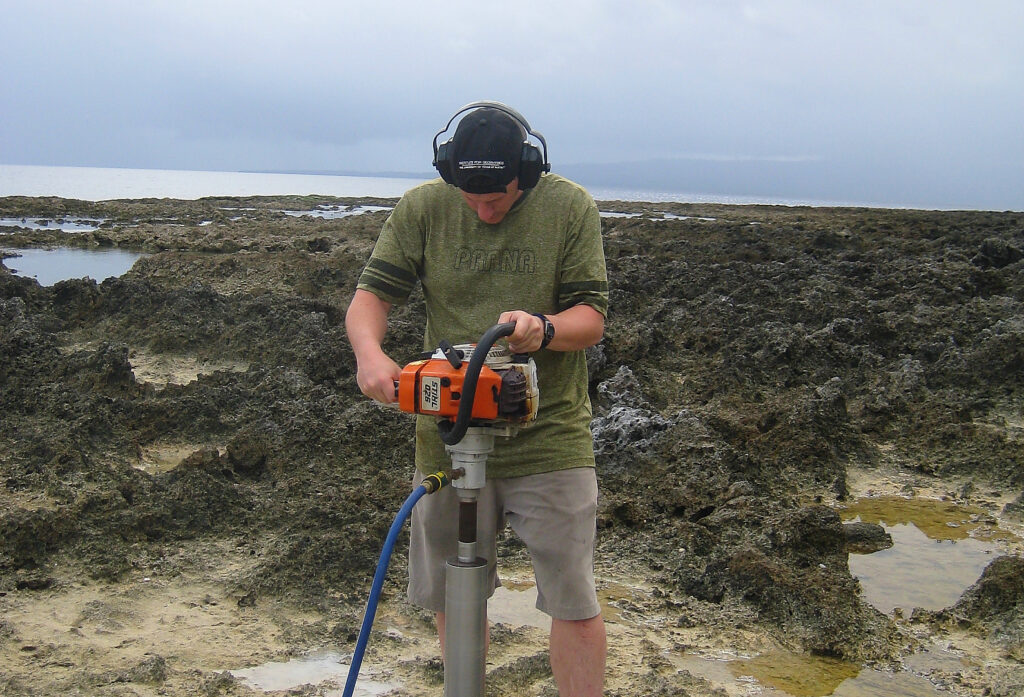
Allison Lawman is in The University of Texas at Austin paleoclimate archive, laying out pieces of featureless, bleached white coral beneath a glistening medical scanner. Around her, the warehouse is a medley of coral, tools, machinery and a line of shelves housing one of the most significant collections of coral cores held by a university.
“What many people don’t know is that corals have growth bands, just like tree rings,” she said. “To see the banding, we carefully slice a thin slab from the core and take an X-ray.”
Lawman is a Jackson School of Geosciences graduate student working at the University of Texas Institute for Geophysics (UTIG), where she is part of a group of scientists who are solving some of the most pressing questions about our enigmatic climate.
The corals, according to Lawman, are important because they tell us, month by month, what the ocean was like when the coral was alive, which was often long before humans were around.
“Each one of these is like looking at a thermometer from the past,” she said. “We can also tell how salty the ocean was, which is often related to how much rain there was.”
Lawman and her colleagues at UTIG are studying corals to find traces of two recurring climate events in the Pacific Ocean known as El Niño and La Niña The goal is to learn how to better predict when they will happen and their impacts on the world.
El Niño begins as a bulge of warm water that drifts below the ocean surface across the equator in the Pacific Ocean. When it reaches the eastern Pacific, it bursts to the surface, warming the atmosphere and triggering a cascade of weather disruptions across the world. El Niño carries the seed of its own destruction, however; about a year later, a slower blob of cold water arrives, putting an end to the warming and initiating La Niña, the opposite, equally disruptive cold phase. Typically, each phase runs its course within a year. Sometimes, however, El Niño or La Niña will continue for a second or third year. The prolonged effects of these back-toback events cost billions of dollars in ecological damage, including fish stock crashes in Peru, crop failure in China and cataclysmic flooding in Australia.
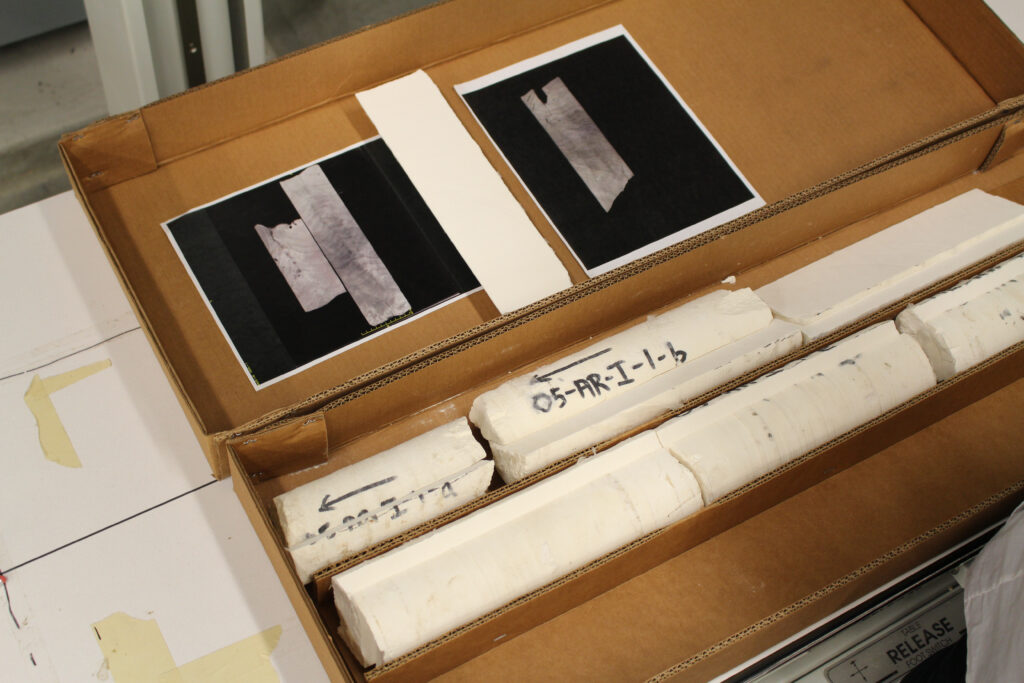
For the southern United States, long lasting El Niño events mean warm, wet winters and the kind of deluges that flooded Texas throughout 2016 and 2018. Long-lasting La Niña events, on the other hand, can bring months of drought. In the 1950s, a seven-year Texas drought, the most severe on record, was caused by back-to-back La Niñas that pushed moisture-bringing air currents away and left the southern Great Plains to wither to dust. More recently, a similar string of events was behind the 2011 Texas drought that left the state parched for over five years.
Knowing when El Niño and La Niña will strike and how long they will last could mean life or death for agriculture, shipping, homeowners, insurance companies and many others. Today’s climate forecasts, however, stretch no further than eight months and struggle to account for the impact of global climate change.
This is where UTIG climate scientists step in. Ten years ago, UTIG’s former director, Terry Quinn, saw an opportunity to leverage the institute’s strengths with a team of experts who could tackle these kinds of big questions about our world’s climate.

“We combine climate modeling, statistical analysis, laboratory work, theory and expeditionary science in ways you won’t find anywhere else,” he said.
Today, UTIG’s climate researchers are using all the tools at their disposal to advance predictions about El Niño and La Niña and understand how their effects will change as the world warms.
Predicting the Next Climate Disaster
In 2017, UTIG research scientists Pedro DiNezio and Yuko Okumura correctly predicted that the La Niña event that began earlier that year would continue into a second year, meaning another year without rain for much of Texas and the East Coast. Today, UTIG scientists think they are on the verge of breakthroughs that will allow forecasts to be made up to two years ahead, giving farmers and water management services crucial time to prepare.
“Long term predictions of long-lasting El Niño and La Niña events are possible,” said Xian Wu, a Jackson School graduate student who is working on the problem with Okumura and DiNezio.
Earlier this year, Wu published a paper in the Journal of Climate that gives an incredibly detailed analysis of climate behavior. Her results, which could help predict the duration of individual events, were elegantly simple: El Niño events that begin in spring or early summer quickly fizzle, and those that develop later return for a second year; La Niña events that follow a strong El Niño will stretch into two years, whereas a weak El Niño will generate a short-lived La Niña.
Wu made this discovery by analyzing climate records spanning the past 120 years and confirmed her hypothesis using a computer model that simulates the Earth’s climate. Her work reveals an intricate network of oceanic and atmospheric mechanisms that can trigger climate feedback loops as far away as the North Atlantic and the Indian Ocean. Depending on each individual event, these either return to smother the event early or fuel it for another year or longer.
Separating Climate Change From Climate Variation
The computer model Wu used to tease out the parts of the system was the state-of-the-art Community Earth System Model, one of the most sophisticated in the world. The model works by deconstructing the Earth’s climate into little 3D pixels of ocean, land and atmosphere, and applying basic laws of physics. The result is a simulation that is unprecedented — and often frightening — in its realism.
DiNezio said that with the right math, the model can do amazing things.
“You can actually see El Niño spontaneously emerging from the equations, ” he said.
Although simulations can predict how greenhouse gas emissions, volcanic eruptions and sunspots can warm or cool the climate year to year, these predictions are muddied by longer periods of climate ups and downs, on the scale of decades and even centuries. This kind of longterm climate variability can skew predictions and distract. For example, in the early years of the 21st century, many wrongly thought a short-lived slow-down in global warming was a sign that human impact on the climate had been exaggerated.
“Understanding how these natural variations are generated is the key to improve climate predictions for the coming decades,” said Okumura, who studies long-term climate patterns with Tianyi Sun, a recent doctoral graduate from the Jackson School.
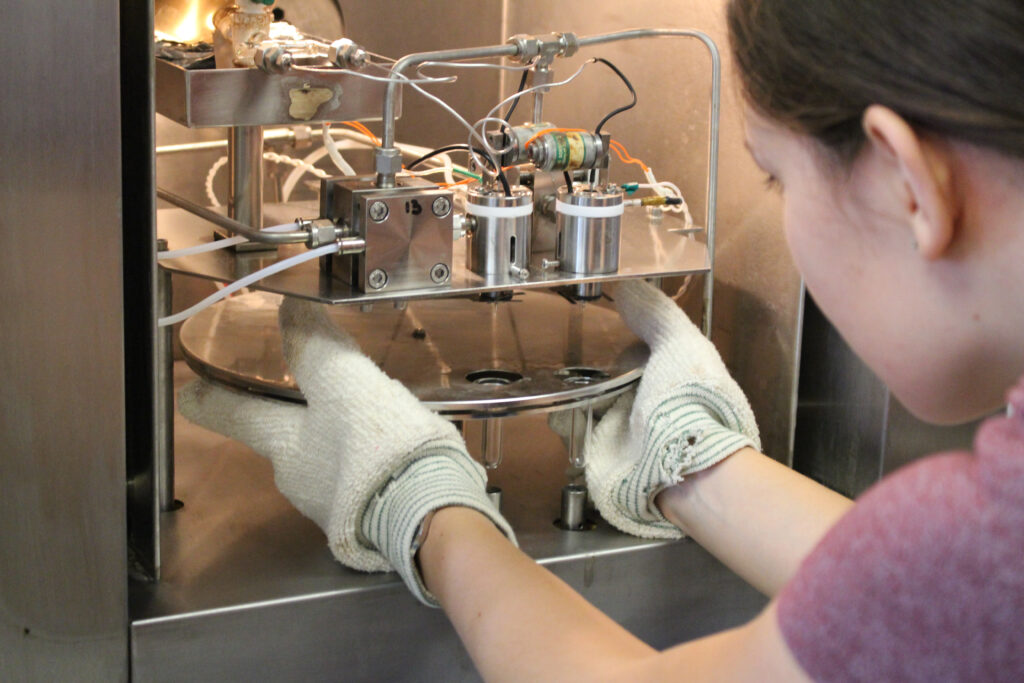
They looked beyond the tropical Pacific and found that the ocean and atmospheric conditions where El Niño and La Niña develop were being partly decided in the vast expanse of ocean lying south of the tropics. Here, changes in ocean and air circulation slowly move north toward the equator over several years, essentially changing the conditions in which El Niño and La Niña form and develop over very long periods.
Okumura said that Sun’s work was the first to clearly demonstrate the origins of long-term tropical Pacific variability and its impact on El Niño and La Niña.
“The knowledge we gained through this research is critical to understanding future changes in El Niño and La Niña,” Okumura said.
Is Global Climate Change Fueling the Fire?
Overwhelmingly, evidence shows that the effects of El Niño and La Niña are becoming more severe as our world’s climate warms. How this will play out is perhaps the most significant question the group is tackling.
“When we look at historical records and when we run climate simulations, we see that a warmer climate leads to more pronounced drought and rain during El Niño and La Niña,” said DiNezio.
Sabiha Tabassum, a graduate research assistant at UTIG, is investigating extreme rainfall events that occur during El Niño and La Niña. Her analysis of rainfall data shows that these events are becoming worse as the climate warms. Tabassum, who worked in water resources engineering in Bangladesh before joining UTIG, said that water infrastructure will face much greater stresses in the future. For example, events such as the New Orleans levee failures during Hurricane Katrina might become more common.
Past Climate From Coral Dust
Back in the lab, Lawman is showing Joseph Arias, an undergraduate student at the Department of Geological Sciences, how to drill a series of neat holes into a length of coral using a dentist’s drill. The coral dust they collect is dissolved in tiny vials of phosphoric acid, each sample representing a single month of coral growth.
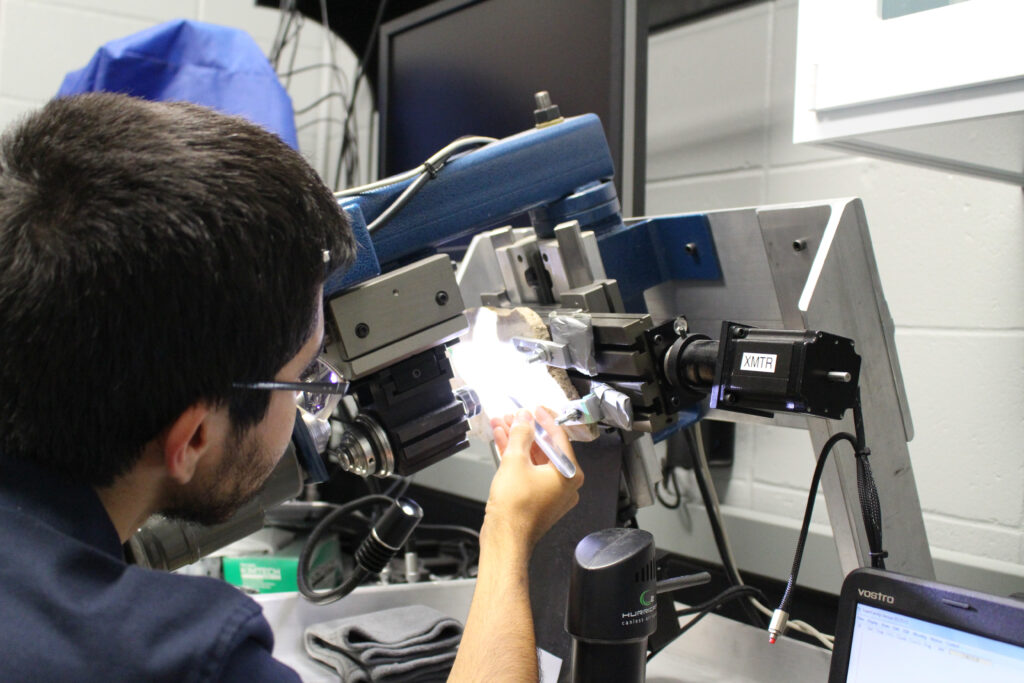
A mass spectrometer measures the ratio of two different oxygen isotopes, telling them how cold and salty the ocean was when the coral was alive. Another instrument called an inductively coupled plasma optical emission spectrometer measures the coral’s chemistry.
“The way it works is really quite interesting. It drops tiny amounts of coral into a plasma that burns hotter than the sun and then measures the light that’s given off as the sample is being obliterated,” Lawman said.
The intensity of that light allows the machine to deduce the concentration of calcium and strontium in the bones of the coral. Under normal conditions, coral will grow their skeleton with calcium. In cooler waters, however, coral prefer to use strontium: the cooler the water, the more strontium. The ratio of the two elements in the skeleton gives Lawman and Arias an accurate month-by-month measurement of ocean temperatures when the coral was alive — in this case, a period about 900 years ago called the Medieval Climate Anomaly.
“This was a time when we know the Northern Hemisphere experienced a period of warming, similar to modern-day temperatures,” said Lawman. “But we don’t know very much about the tropics and what El Niño was doing.”
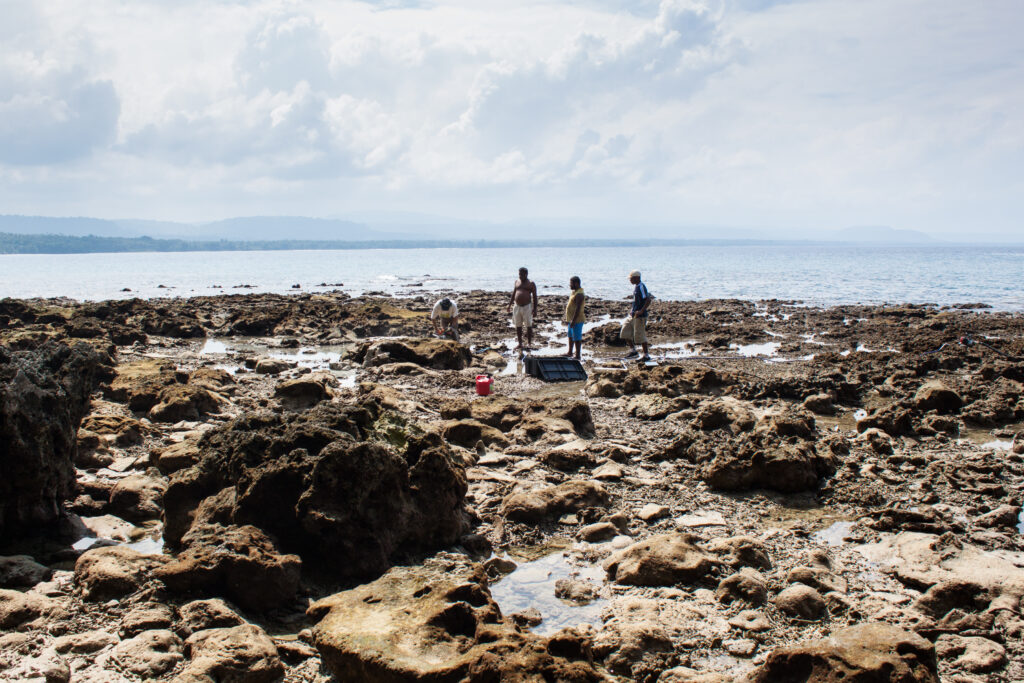
By drawing comparisons with modern observations, they can find clues that show how weather patterns change in a warmer world and create a baseline for measuring the extent of human impact on climate change.
Lawman found that the range of extreme El Niño and La Niña events during the Medieval Climate Anomaly was similar to those observed during the early 20th century.
“However, at no point did they meet or surpass what we’ve seen the last 40 years,” she said.
On the Frontlines of Climate Research
According to the researchers, the most useful analog for modern global climate change is, surprisingly, not a period of past global warming, but the peak of the last ice age, when Canada and parts of Europe were buried beneath 2 miles of ice.
Much about this period 21,000 years ago, known as the Last Glacial Maximum, was very different from today. Global temperatures were 10 degrees cooler, and much of the world’s oceans were frozen in thick ice sheets that left sea levels up to 400 feet lower than they are in modern times.
Such extreme and global effects make it much easier for scientists to see El Niño and La Niña’s shadow in the sediments, ice and remains of corals that grew at that time.
Finding these fossil corals, however, is a significant challenge. Coral skeletons quickly erode when reefs die. Those that remain intact mostly lie buried beneath hundreds of feet of water and rock. About 10 years ago, Fred Taylor, a senior UTIG researcher who studies neotectonics, realized he could use his knowledge of Earth processes to get around the problem.
“We looked at global tectonic and sea-level reconstructions for the last glacial period and calculated the most likely spots to find uplifted corals,” said Taylor.
By winding back the clock of tectonic plate movement, Taylor pinpointed exactly where ancient coral reefs had been brought to the surface. One such location was the South Pacific island of Vanuatu, but getting to the corals was not as straightforward as he had anticipated.
“The fossil corals are on land but in very hard-to-reach places such as steep, rocky slopes,” said Taylor.
Younger corals grow on top of the older ones, meaning that you need a much longer drill to reach the older coral underneath, he added.
A UTIG Prototype: The Ultra-Portable Shallow Coring Drill
With no commercially available solution, Taylor and fellow UTIG climate scientist Jud Partin decided to build their own. The Ultra-Portable Shallow Coring drill is a prototype device designed to drill cores up to 656 feet below the surface but light enough to be broken down and carried by hand over rocky terrain. After testing the drill at the Jackson School’s White Family Outdoor Learning Center in July 2019, Taylor, Partin and Jackson School graduate student Rob Domeyko headed off to Vanuatu in September to find and gather fossil corals using the new drill. The plan is to collect several hundred feet of fossilized coral, which, if successful will exceed the achievements of multimillion- dollar ocean drilling projects at a fraction of the cost.
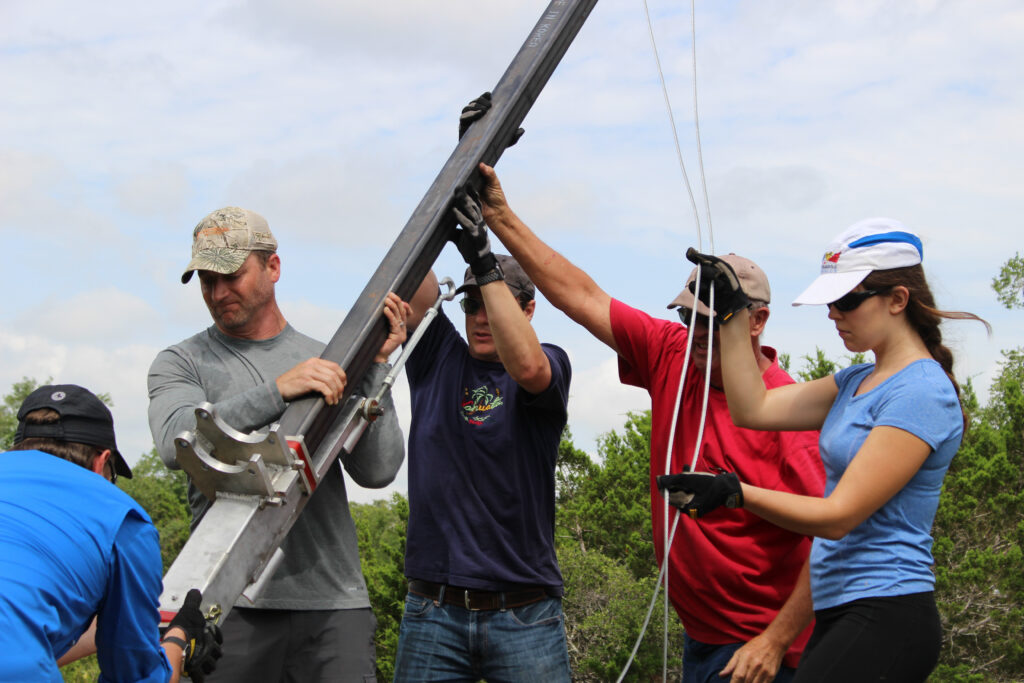
“We’re one of only a few research groups to have ever collected coral samples from the Last Glacial Maximum, and we will be the first to gather this much,” said Partin.
Although Taylor’s calculations have narrowed the ancient corals’ likely location to a single stretch of beach, finding them will require skill, perseverance and quite a bit of luck.
“It’s like finding buried treasure on a map without an X,” said Partin.
Fortunately, Taylor and Partin are used to overcoming tough challenges in the field and making the most of limited resources. The fieldwork partnership they have cultivated in recent years has already achieved many important firsts, and the scientists are confident they will succeed.
The Vanuatu corals will give the scientists data they need to understand how weather patterns change under drastically different climate conditions. The next challenge will be to feed this data into a refined climate model that can predict how El Niño and La Niña — and their global impacts — will change in the future.
“The integrated approach at UTIG is unique,” said DiNezio. “We’re able to answer difficult questions about the climate by looking at past, present and future all together.”
Indeed, by combining ice age data with computer simulations of our climate, UTIG researchers have already shown alarming signs of what the future might hold.
In 2018, DiNezio found evidence of ancient El Niño and La Niña-like climate patterns in the Indian Ocean, where they would be unheard of today. What worries DiNezio is that his climate simulations show this happening again in a warmer world. If he is right, the implications are serious for heavily populated countries of the region.
Alongside increasing evidence that extreme weather events are becoming more frequent and more destructive as the world warms, it is clear there is much to be concerned about. However, using ancient corals, computer models, chemical sensors, and drills, UTIG’s climate researchers are showing us how understanding the past is key to knowing the future. We can be hopeful that with this knowledge scientists, policy makers and vulnerable communities can learn how to better prepare for such eventualities.

